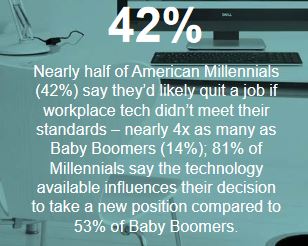How do you picture the workplace 20 years from now? Do offices still exist, or have we completely traded in headquarters for personal quarters? Is the workforce more collaborative or more siloed? More productive or distracted? Is it even human?
According to the 2016 Dell and Intel Future Workforce Study, it’s clear that while the coming wave of technology, particularly artificial intelligence, does cause some apprehension among workers (31% worry robots will take their jobs), it turns out most people are eagerly waiting for tech to take on a larger role in the workplace. In fact, 58% of workers say they’d prefer high-tech perks like the Internet of Things (IoT), augmented/virtual reality (AR/VR) or artificial intelligence (AI); while only 29% would prefer low-tech perks like ping pong tables and office dogs. And 82% of millennials (along with 67% of workers 35+) said office tech would influence them when deciding whether or not to take a job.
[clickToTweet tweet=”57% of workers say they expect to be working in a smart office offering IoT by 2021.” quote=”57% of workers say they expect to be working in a smart office offering IoT and other technologies in the next five years.”]
 Does that timeframe surprise you? There’s no doubt these expectations are going to catch a large number of companies off guard in the coming years, especially since 42% of millennials and a quarter of workers 35 years old and higher say they’d be willing to leave a job over substandard tech. Thus, today’s companies have two options that might feel ironic in light of workers’ AI-related fears: Provide a smart office or risk losing your top talent.
Does that timeframe surprise you? There’s no doubt these expectations are going to catch a large number of companies off guard in the coming years, especially since 42% of millennials and a quarter of workers 35 years old and higher say they’d be willing to leave a job over substandard tech. Thus, today’s companies have two options that might feel ironic in light of workers’ AI-related fears: Provide a smart office or risk losing your top talent.
What is a smart office?
There are three main benefits associated with the rise of the smart office:
1. Smart offices make workers smarter.
Upskill, (formerly APX Labs) develops wearable software technology that workers can use to get heads-up instructions, instant validation of their actions and other time-saving data interaction capabilities as they work.
While it’s true some workers are afraid they’ll either be replaced by AI or become reliant on it (23%), they also see it as a digital helper (30%) and a proactive, priority-driven productivity enabler (20%). (Notably, only 5% of respondents were worried about their friends dating robots, so perhaps humans will not become wholly obsolete!)
2. Smart offices are highly connected ecosystems that understand workers’ needs and support them through technology and design.
39% of workers are excited about the opportunity to leverage IoT to wirelessly connect devices and analyze data in real time. Another innovative company, Comfy, is using IoT to connect employees directly to their companies’ HVAC systems, enabling workers to “vote” on the temperature settings for their area of the building. 24% of workers say they’re excited about the idea of using IoT to tailor workspaces to personal preferences in this way.
3. Smart offices support remote work.
52% of employees work outside the office at least a few times a week, so smart offices will need to provide seamless and secure file sharing and collaboration capabilities. And while workers still prefer face-to-face communication overall, more than half say that remote teams and better communications technology will supplant that need in the future.
There is a catch – even with all this technology on the horizon, workers say the biggest thing companies can do to improve their productivity is to just make sure the technology offered actually works. Slow or glitchy software programs (19%) and slow or glitchy devices (17%) are two of the top three time wasters that employees face at work, beating out meetings (14%) and water cooler conversations (8%).
And one in three workers say it’s probably a good thing the workforce is going remote because their technology at home is better than in the office. However, using personal technology for business brings a slew of security concerns to organizations; therefore, keeping employees tied to office devices is the preferred option of IT departments, if not for HR.
There’s a long way to go before companies catch up with worker expectations for the smart office, but the path is clear. First, make sure you’re providing reliable software and devices to enable, rather than hinder workers whether they’re in the office or working remotely. Then, develop a long-term resource investment plan that recognizes technology and worker recruitment/retention are no longer separate line items. If you want to get the best performance out of the best workers, sell the ping pong tables and invest in productivity-enabling tech.
Keep the office dog, though. After all, we’re not machines. Yet.
